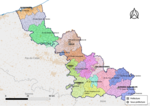Siege of Dunkirk (1658)

The siege of Dunkirk in 1658 was a military operation by France and the Commonwealth of England intended to capture the fortified port city of Dunkirk, Spain's greatest privateering base, from a Spanish garrison strengthened with English Royalists and French Fronduers. Dunkirk (Dutch for 'Church in the dunes') was a strategic port on the southern coast of the English Channel in the Spanish Netherlands that had often been a point of contention previously and had changed hands a number of times. Privateers operating out of Dunkirk and other ports had cost England some 1,500 to 2,000 merchant ships in the past year. The French and their English Commonwealth allies were commanded by Marshal of France Turenne. The siege would last a month and featured numerous sorties by the garrison and a determined relief attempt by the Spanish army under the command of Don Juan of Austria and allied English Royalists led by Duke of York and rebels of the French Fronde under the Great Condé that resulted in the battle of the Dunes.
Excerpt from the Wikipedia article Siege of Dunkirk (1658) (License: CC BY-SA 3.0, Authors, Images).Siege of Dunkirk (1658)
Rue Jean Jaurès, Dunkirk
Geographical coordinates (GPS) Address Nearby Places Show on map
Geographical coordinates (GPS)
| Latitude | Longitude |
|---|---|
| N 51.0383 ° | E 2.3775 ° |
Address
Rue Jean Jaurès 15
59140 Dunkirk (Dunkerque)
Hauts-de-France, France
Open on Google Maps









